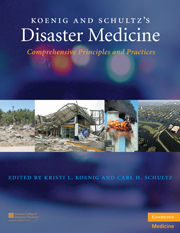Book contents
- Frontmatter
- Contents
- List of Contributors
- Contributor Biographies
- Foreword
- Preface
- Acknowledgments
- PART I CONCEPTUAL FRAMEWORK AND STRATEGIC OVERVIEW
- PART II OPERATIONAL ISSUES
- 9 Public Health and Emergency Management Systems
- 10 Legislative Authorities and Regulatory Issues
- 11 Syndromic Surveillance
- 12 Triage
- 13 Personal Protective Equipment
- 14 Decontamination
- 15 Quarantine
- 16 Mass Dispensing of Antibiotics and Vaccines
- 17 Management of Mass Gatherings
- 18 Transportation Disasters
- 19 Emergency Medical Services Scene Management
- 20 Healthcare Facility Disaster Management
- 21 Mass Fatality Management
- 22 Crisis and Emergency Risk Communication
- 23 Telemedicine and Telehealth Role in Public Health Emergencies
- 24 Complex Public Health Emergencies
- 25 Patient Identification and Tracking
- PART III CLINICAL MANAGEMENT
- Index
- Plate section
- References
18 - Transportation Disasters
from PART II - OPERATIONAL ISSUES
Published online by Cambridge University Press: 05 August 2011
- Frontmatter
- Contents
- List of Contributors
- Contributor Biographies
- Foreword
- Preface
- Acknowledgments
- PART I CONCEPTUAL FRAMEWORK AND STRATEGIC OVERVIEW
- PART II OPERATIONAL ISSUES
- 9 Public Health and Emergency Management Systems
- 10 Legislative Authorities and Regulatory Issues
- 11 Syndromic Surveillance
- 12 Triage
- 13 Personal Protective Equipment
- 14 Decontamination
- 15 Quarantine
- 16 Mass Dispensing of Antibiotics and Vaccines
- 17 Management of Mass Gatherings
- 18 Transportation Disasters
- 19 Emergency Medical Services Scene Management
- 20 Healthcare Facility Disaster Management
- 21 Mass Fatality Management
- 22 Crisis and Emergency Risk Communication
- 23 Telemedicine and Telehealth Role in Public Health Emergencies
- 24 Complex Public Health Emergencies
- 25 Patient Identification and Tracking
- PART III CLINICAL MANAGEMENT
- Index
- Plate section
- References
Summary
OVERVIEW
The Red Cross defines a disaster as an event causing 10 or more deaths and/or 100 injuries. According to the Red Cross World Disaster Report, transportation-related disasters are a major source of morbidity and mortality, causing 45% of all disaster-related deaths in Africa. During the 1990s, approximately 80,000 people were killed in different disasters in the world each year. This number may be compared with the “low virulent epidemic” of road fatalities that annually kill approximately 1.2 million people (16.1/100,000 inhabitants) and injure 50 million people to such an extent that they require medical attention. In the United States alone, 43,000 are killed annually on the highways.
In commercial aircraft crashes, approximately 1,000 people are killed each year. In sea disasters, the events are more infrequent, but may sometimes engage a few thousand victims each. A few major train incidents are reported annually with sometimes hundreds of fatalities. Bus and coach crashes kill fewer people in each incident than in prior times but apparently are increasing in frequency. A common feature is, however, that many of these incidents occur in rural and remote areas, creating special rescue problems.
In most of these categories, both unintentional and intentional injury events have been reported. More and more frequent suicide attacks have introduced a new dimension of intentional violence, rendering many previous preventive strategies in-effective.
- Type
- Chapter
- Information
- Koenig and Schultz's Disaster MedicineComprehensive Principles and Practices, pp. 253 - 274Publisher: Cambridge University PressPrint publication year: 2009



